Many Canadian business owners look to the U.S. as a first place to expand internationally. That was true for Grace & Stella, the skincare and beauty line I started in 2015. We launched our products through Amazon, helping us to reach a large customer base in the U.S. and grow beyond the limitations of the Canadian market.
Europe seemed like the next logical step for us. Many Canadian business owners don’t consider Europe as a go-to market for expansion. It can seem far away and untested. But if you aren’t thinking about Europe as part of your business growth plans, you may be leaving money on the table.
Expanding into Europe presents different challenges than selling in the U.S., yes, but it’s very much within reach. During a recent EDC webinar looking at the benefits of Canada’s new free trade agreement with Europe, I was asked to share my experiences about the challenges we faced growing our business in Europe and how we overcame them. The Comprehensive and Economic Trade Agreement (CETA) that Canada signed with Europe last year has made it easier than ever for Canadians to do business with the 28 member countries. Here’s how you can get started.
1. Understand the opportunity
There is huge demand in Europe for Canadian-made products. Canadian businesses have a reputation for quality. You may not realize the brand equity you already have there. European customers were calling and emailing us about our products as soon as we launched on the U.S.-based Amazon platform, which is the main reason we decided to test the European market for expansion. It’s common for Europeans to research a brand. If they see it as an already reputable brand in Canada and the U.S., it makes it easier for them to make a quick decision to purchase.
2. Start with a country that makes sense for your business
When we first expanded into Europe we started in the U.K. It also allowed us to get a foothold in a market with a similar culture to Canada, and we didn’t have to make major changes to our packaging to accommodate language or local preferences.
3. Take advantage of e-commerce platforms with an established reputation
Grace & Stella sells most of its products through Amazon, an important element of our European strategy. Amazon takes care of our logistics, distribution and fulfillment. They also help us with a big part of our customer service, leaving us free to concentrate on other aspects of the business. Additionally, selling through Amazon has helped us build trust with European customers who already have a positive relationship with the platform.
4. Work with local partners
When we first began our European expansion, we made the mistake of trying to do everything ourselves—from formulation and packaging, to distribution and marketing. But doing business in Europe is different than it is in Canada or the U.S. There was a lot to understand and it was challenging.
Within a few months we realized we needed to work with local experts to help us navigate all the nuances. Reaching out to locals in Europe can help you understand local laws, regulations and tax systems. But local expertise also helps you recognize varying customer behaviours, and best practices for marketing in EU countries.
Packaging is a good example. Don’t assume the French text on your packaging translated in Canada will meet the standard. Nuanced language means it will need to be adapted for French-speaking customers in Europe. A local expert can help you identify these and other subtle differences or business requirements.
If you want to better understand the opportunities for your Canadian business in Europe, including my personal experience, you can watch EDC's CETA webinar on Canada-Europe trade on-demand







